BMSK5004 - Project Management: Tools, Techniques, and Plan
VerifiedAdded on 2023/05/27
|24
|6363
|185
Report
AI Summary
This report provides a critical assessment of project management tools and techniques, focusing on their usefulness in managing projects within an organization, particularly in the context of software development and launch at NEXT company. It evaluates various project management tools such as Gantt charts, work breakdown structures, and agile methodologies, highlighting their benefits in planning, scheduling, and risk management. The report also includes a project plan for software development and launch, detailing project background, aims, objectives, scope, assumptions, constraints, deliverables, key stakeholders, communication plan, and justification. Furthermore, it emphasizes the importance of aligning project objectives with stakeholder needs, customer-centric product development, and effective communication for successful project implementation. The report concludes by underscoring the role of project management tools in enhancing collaboration, managing project aspects like time, quality, and cost, and fostering better client relationships. Desklib provides access to similar project management reports and study resources for students.
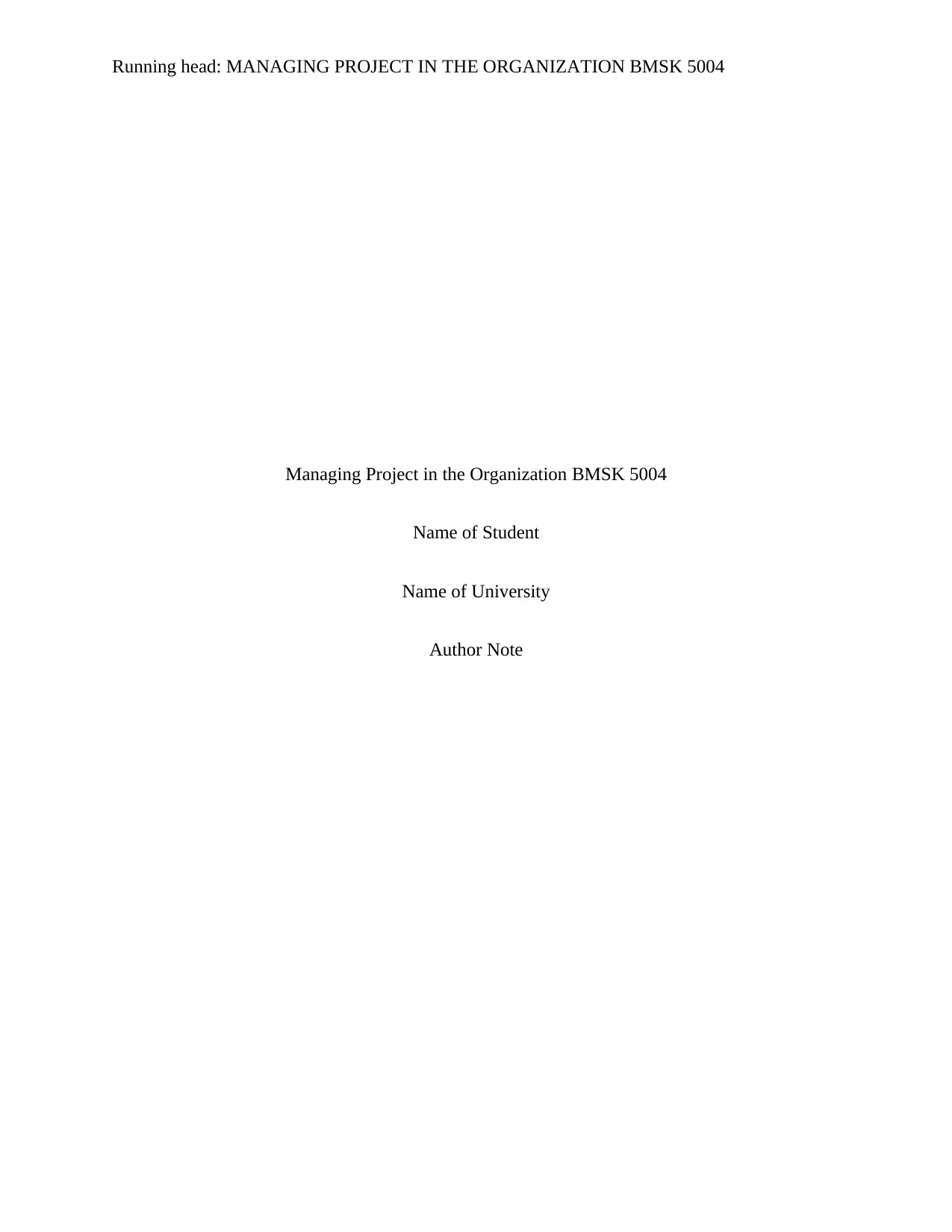
Running head: MANAGING PROJECT IN THE ORGANIZATION BMSK 5004
Managing Project in the Organization BMSK 5004
Name of Student
Name of University
Author Note
Managing Project in the Organization BMSK 5004
Name of Student
Name of University
Author Note
Paraphrase This Document
Need a fresh take? Get an instant paraphrase of this document with our AI Paraphraser
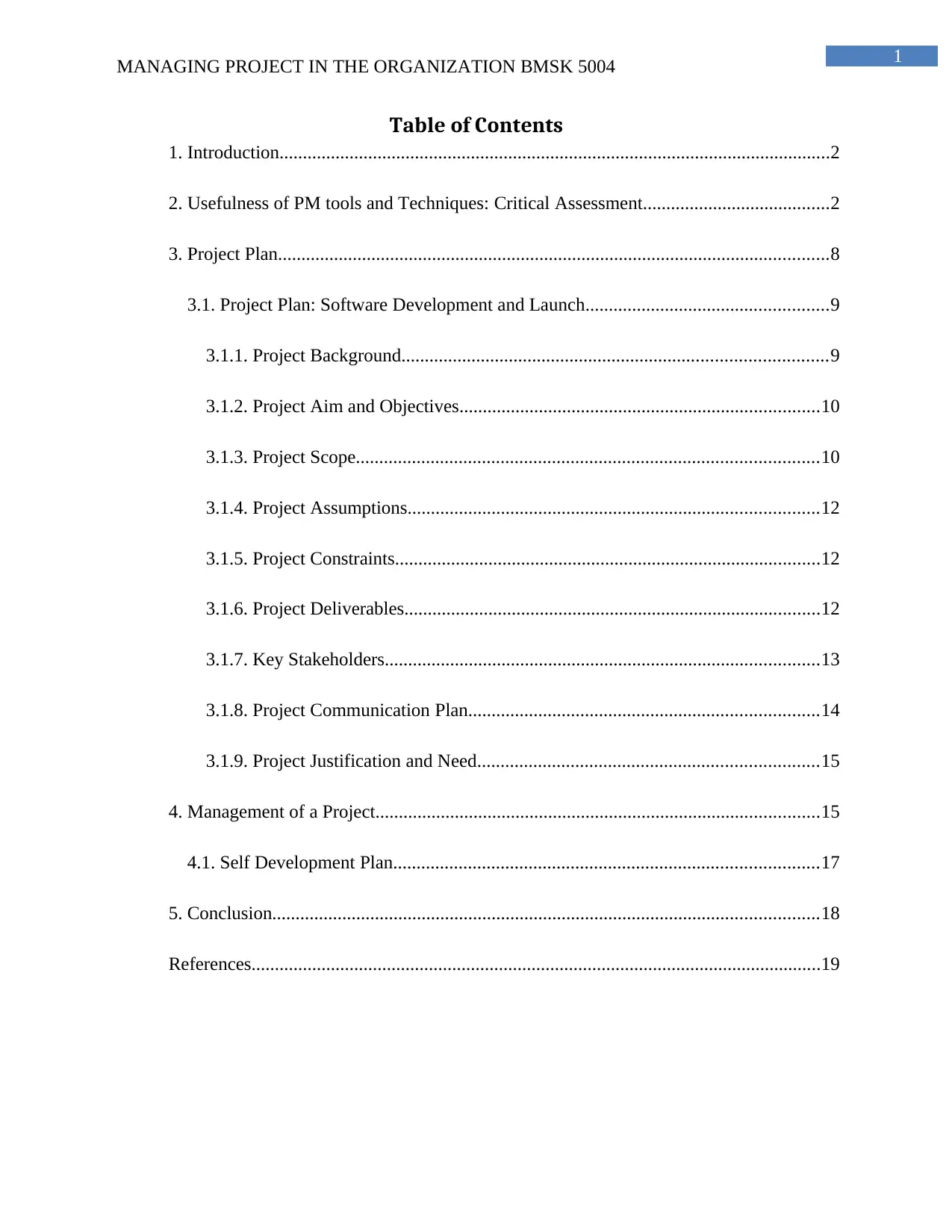
1
MANAGING PROJECT IN THE ORGANIZATION BMSK 5004
Table of Contents
1. Introduction......................................................................................................................2
2. Usefulness of PM tools and Techniques: Critical Assessment........................................2
3. Project Plan......................................................................................................................8
3.1. Project Plan: Software Development and Launch....................................................9
3.1.1. Project Background...........................................................................................9
3.1.2. Project Aim and Objectives.............................................................................10
3.1.3. Project Scope...................................................................................................10
3.1.4. Project Assumptions........................................................................................12
3.1.5. Project Constraints...........................................................................................12
3.1.6. Project Deliverables.........................................................................................12
3.1.7. Key Stakeholders.............................................................................................13
3.1.8. Project Communication Plan...........................................................................14
3.1.9. Project Justification and Need.........................................................................15
4. Management of a Project...............................................................................................15
4.1. Self Development Plan...........................................................................................17
5. Conclusion.....................................................................................................................18
References..........................................................................................................................19
MANAGING PROJECT IN THE ORGANIZATION BMSK 5004
Table of Contents
1. Introduction......................................................................................................................2
2. Usefulness of PM tools and Techniques: Critical Assessment........................................2
3. Project Plan......................................................................................................................8
3.1. Project Plan: Software Development and Launch....................................................9
3.1.1. Project Background...........................................................................................9
3.1.2. Project Aim and Objectives.............................................................................10
3.1.3. Project Scope...................................................................................................10
3.1.4. Project Assumptions........................................................................................12
3.1.5. Project Constraints...........................................................................................12
3.1.6. Project Deliverables.........................................................................................12
3.1.7. Key Stakeholders.............................................................................................13
3.1.8. Project Communication Plan...........................................................................14
3.1.9. Project Justification and Need.........................................................................15
4. Management of a Project...............................................................................................15
4.1. Self Development Plan...........................................................................................17
5. Conclusion.....................................................................................................................18
References..........................................................................................................................19
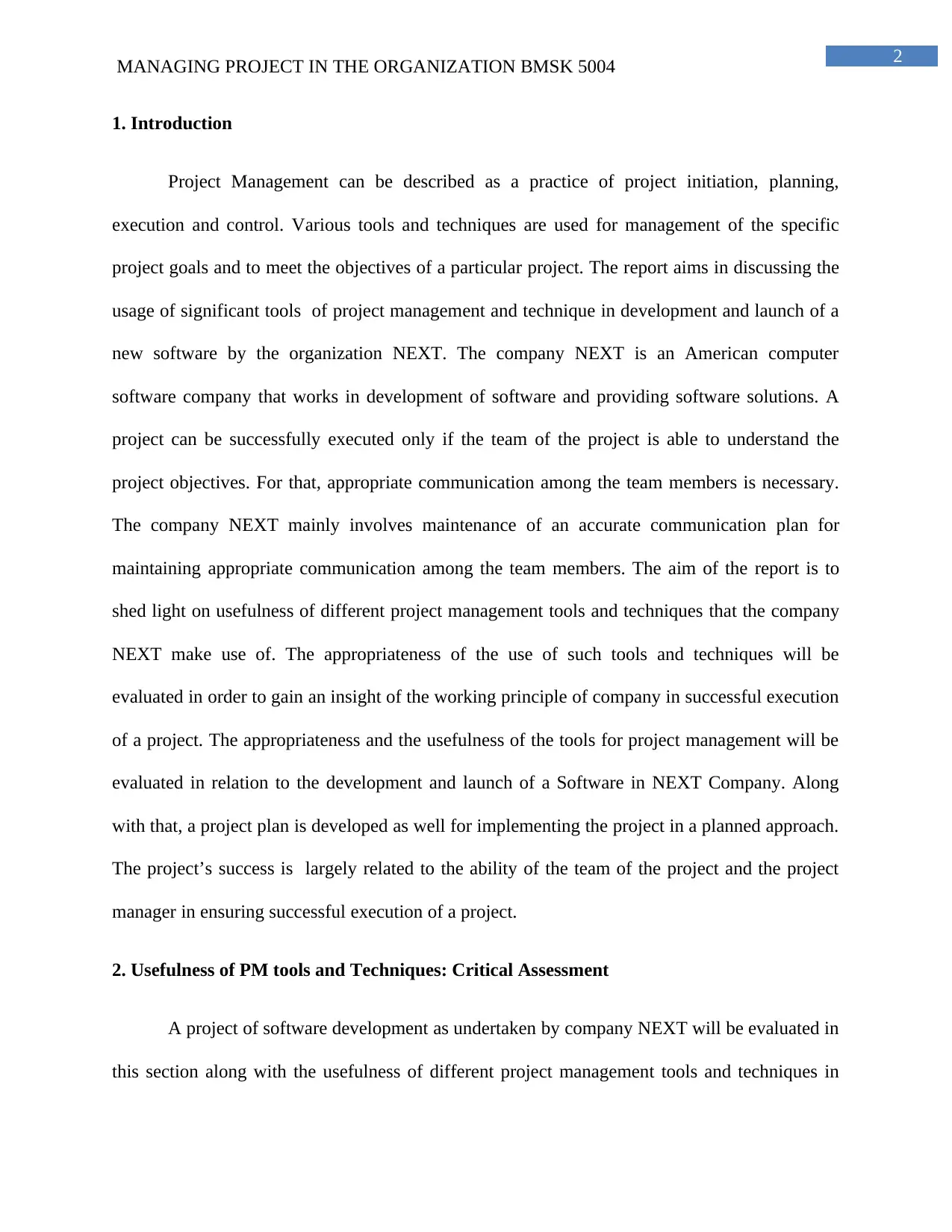
2
MANAGING PROJECT IN THE ORGANIZATION BMSK 5004
1. Introduction
Project Management can be described as a practice of project initiation, planning,
execution and control. Various tools and techniques are used for management of the specific
project goals and to meet the objectives of a particular project. The report aims in discussing the
usage of significant tools of project management and technique in development and launch of a
new software by the organization NEXT. The company NEXT is an American computer
software company that works in development of software and providing software solutions. A
project can be successfully executed only if the team of the project is able to understand the
project objectives. For that, appropriate communication among the team members is necessary.
The company NEXT mainly involves maintenance of an accurate communication plan for
maintaining appropriate communication among the team members. The aim of the report is to
shed light on usefulness of different project management tools and techniques that the company
NEXT make use of. The appropriateness of the use of such tools and techniques will be
evaluated in order to gain an insight of the working principle of company in successful execution
of a project. The appropriateness and the usefulness of the tools for project management will be
evaluated in relation to the development and launch of a Software in NEXT Company. Along
with that, a project plan is developed as well for implementing the project in a planned approach.
The project’s success is largely related to the ability of the team of the project and the project
manager in ensuring successful execution of a project.
2. Usefulness of PM tools and Techniques: Critical Assessment
A project of software development as undertaken by company NEXT will be evaluated in
this section along with the usefulness of different project management tools and techniques in
MANAGING PROJECT IN THE ORGANIZATION BMSK 5004
1. Introduction
Project Management can be described as a practice of project initiation, planning,
execution and control. Various tools and techniques are used for management of the specific
project goals and to meet the objectives of a particular project. The report aims in discussing the
usage of significant tools of project management and technique in development and launch of a
new software by the organization NEXT. The company NEXT is an American computer
software company that works in development of software and providing software solutions. A
project can be successfully executed only if the team of the project is able to understand the
project objectives. For that, appropriate communication among the team members is necessary.
The company NEXT mainly involves maintenance of an accurate communication plan for
maintaining appropriate communication among the team members. The aim of the report is to
shed light on usefulness of different project management tools and techniques that the company
NEXT make use of. The appropriateness of the use of such tools and techniques will be
evaluated in order to gain an insight of the working principle of company in successful execution
of a project. The appropriateness and the usefulness of the tools for project management will be
evaluated in relation to the development and launch of a Software in NEXT Company. Along
with that, a project plan is developed as well for implementing the project in a planned approach.
The project’s success is largely related to the ability of the team of the project and the project
manager in ensuring successful execution of a project.
2. Usefulness of PM tools and Techniques: Critical Assessment
A project of software development as undertaken by company NEXT will be evaluated in
this section along with the usefulness of different project management tools and techniques in
⊘ This is a preview!⊘
Do you want full access?
Subscribe today to unlock all pages.

Trusted by 1+ million students worldwide
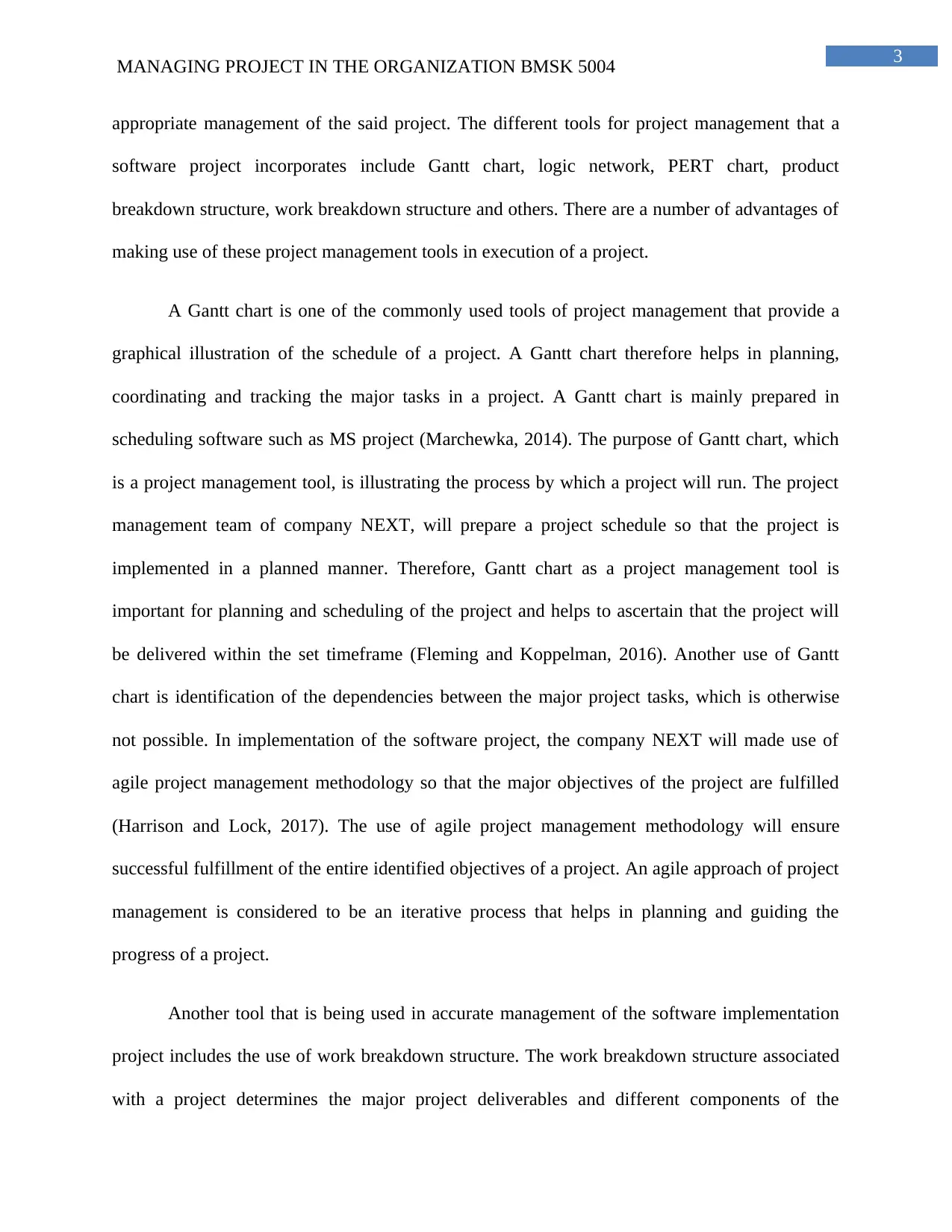
3
MANAGING PROJECT IN THE ORGANIZATION BMSK 5004
appropriate management of the said project. The different tools for project management that a
software project incorporates include Gantt chart, logic network, PERT chart, product
breakdown structure, work breakdown structure and others. There are a number of advantages of
making use of these project management tools in execution of a project.
A Gantt chart is one of the commonly used tools of project management that provide a
graphical illustration of the schedule of a project. A Gantt chart therefore helps in planning,
coordinating and tracking the major tasks in a project. A Gantt chart is mainly prepared in
scheduling software such as MS project (Marchewka, 2014). The purpose of Gantt chart, which
is a project management tool, is illustrating the process by which a project will run. The project
management team of company NEXT, will prepare a project schedule so that the project is
implemented in a planned manner. Therefore, Gantt chart as a project management tool is
important for planning and scheduling of the project and helps to ascertain that the project will
be delivered within the set timeframe (Fleming and Koppelman, 2016). Another use of Gantt
chart is identification of the dependencies between the major project tasks, which is otherwise
not possible. In implementation of the software project, the company NEXT will made use of
agile project management methodology so that the major objectives of the project are fulfilled
(Harrison and Lock, 2017). The use of agile project management methodology will ensure
successful fulfillment of the entire identified objectives of a project. An agile approach of project
management is considered to be an iterative process that helps in planning and guiding the
progress of a project.
Another tool that is being used in accurate management of the software implementation
project includes the use of work breakdown structure. The work breakdown structure associated
with a project determines the major project deliverables and different components of the
MANAGING PROJECT IN THE ORGANIZATION BMSK 5004
appropriate management of the said project. The different tools for project management that a
software project incorporates include Gantt chart, logic network, PERT chart, product
breakdown structure, work breakdown structure and others. There are a number of advantages of
making use of these project management tools in execution of a project.
A Gantt chart is one of the commonly used tools of project management that provide a
graphical illustration of the schedule of a project. A Gantt chart therefore helps in planning,
coordinating and tracking the major tasks in a project. A Gantt chart is mainly prepared in
scheduling software such as MS project (Marchewka, 2014). The purpose of Gantt chart, which
is a project management tool, is illustrating the process by which a project will run. The project
management team of company NEXT, will prepare a project schedule so that the project is
implemented in a planned manner. Therefore, Gantt chart as a project management tool is
important for planning and scheduling of the project and helps to ascertain that the project will
be delivered within the set timeframe (Fleming and Koppelman, 2016). Another use of Gantt
chart is identification of the dependencies between the major project tasks, which is otherwise
not possible. In implementation of the software project, the company NEXT will made use of
agile project management methodology so that the major objectives of the project are fulfilled
(Harrison and Lock, 2017). The use of agile project management methodology will ensure
successful fulfillment of the entire identified objectives of a project. An agile approach of project
management is considered to be an iterative process that helps in planning and guiding the
progress of a project.
Another tool that is being used in accurate management of the software implementation
project includes the use of work breakdown structure. The work breakdown structure associated
with a project determines the major project deliverables and different components of the
Paraphrase This Document
Need a fresh take? Get an instant paraphrase of this document with our AI Paraphraser
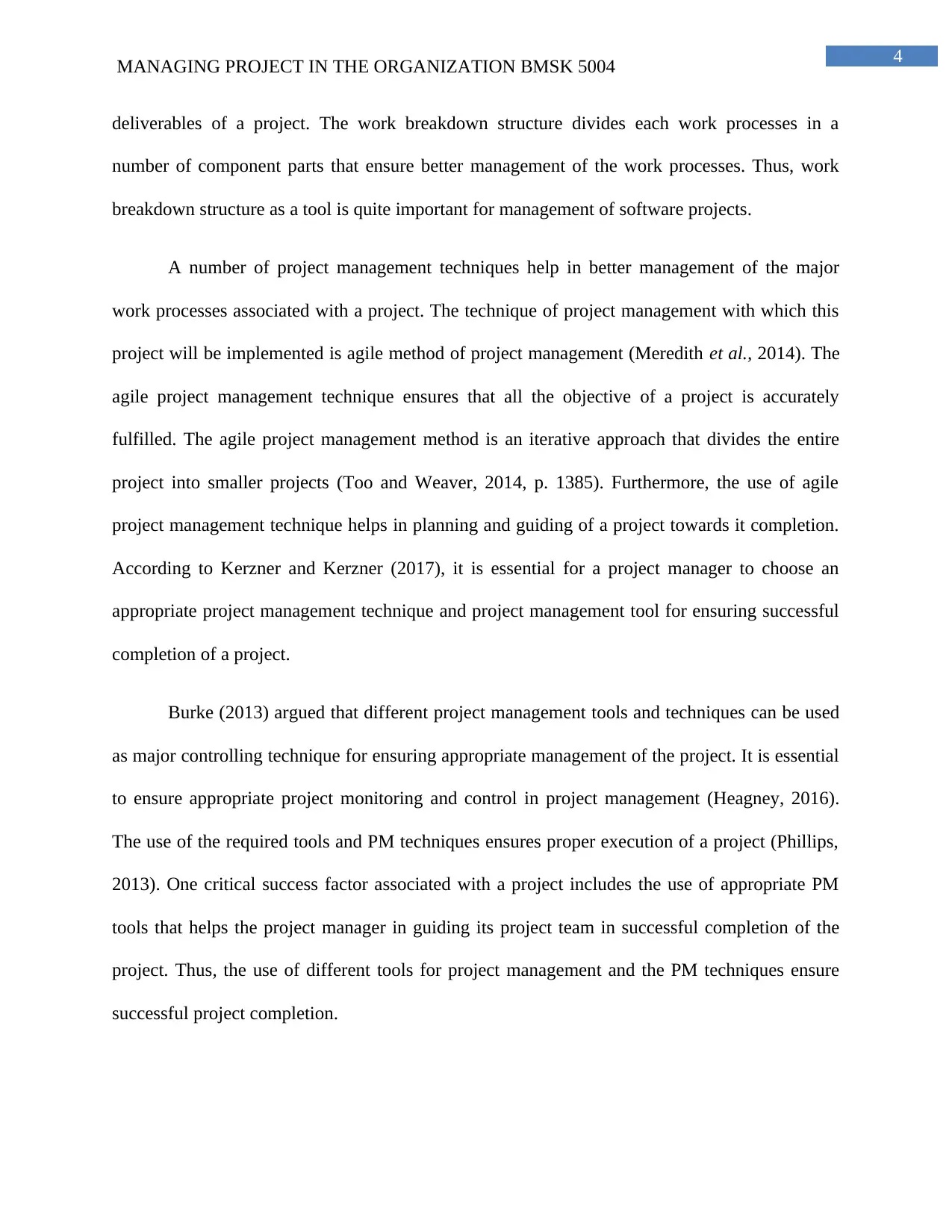
4
MANAGING PROJECT IN THE ORGANIZATION BMSK 5004
deliverables of a project. The work breakdown structure divides each work processes in a
number of component parts that ensure better management of the work processes. Thus, work
breakdown structure as a tool is quite important for management of software projects.
A number of project management techniques help in better management of the major
work processes associated with a project. The technique of project management with which this
project will be implemented is agile method of project management (Meredith et al., 2014). The
agile project management technique ensures that all the objective of a project is accurately
fulfilled. The agile project management method is an iterative approach that divides the entire
project into smaller projects (Too and Weaver, 2014, p. 1385). Furthermore, the use of agile
project management technique helps in planning and guiding of a project towards it completion.
According to Kerzner and Kerzner (2017), it is essential for a project manager to choose an
appropriate project management technique and project management tool for ensuring successful
completion of a project.
Burke (2013) argued that different project management tools and techniques can be used
as major controlling technique for ensuring appropriate management of the project. It is essential
to ensure appropriate project monitoring and control in project management (Heagney, 2016).
The use of the required tools and PM techniques ensures proper execution of a project (Phillips,
2013). One critical success factor associated with a project includes the use of appropriate PM
tools that helps the project manager in guiding its project team in successful completion of the
project. Thus, the use of different tools for project management and the PM techniques ensure
successful project completion.
MANAGING PROJECT IN THE ORGANIZATION BMSK 5004
deliverables of a project. The work breakdown structure divides each work processes in a
number of component parts that ensure better management of the work processes. Thus, work
breakdown structure as a tool is quite important for management of software projects.
A number of project management techniques help in better management of the major
work processes associated with a project. The technique of project management with which this
project will be implemented is agile method of project management (Meredith et al., 2014). The
agile project management technique ensures that all the objective of a project is accurately
fulfilled. The agile project management method is an iterative approach that divides the entire
project into smaller projects (Too and Weaver, 2014, p. 1385). Furthermore, the use of agile
project management technique helps in planning and guiding of a project towards it completion.
According to Kerzner and Kerzner (2017), it is essential for a project manager to choose an
appropriate project management technique and project management tool for ensuring successful
completion of a project.
Burke (2013) argued that different project management tools and techniques can be used
as major controlling technique for ensuring appropriate management of the project. It is essential
to ensure appropriate project monitoring and control in project management (Heagney, 2016).
The use of the required tools and PM techniques ensures proper execution of a project (Phillips,
2013). One critical success factor associated with a project includes the use of appropriate PM
tools that helps the project manager in guiding its project team in successful completion of the
project. Thus, the use of different tools for project management and the PM techniques ensure
successful project completion.
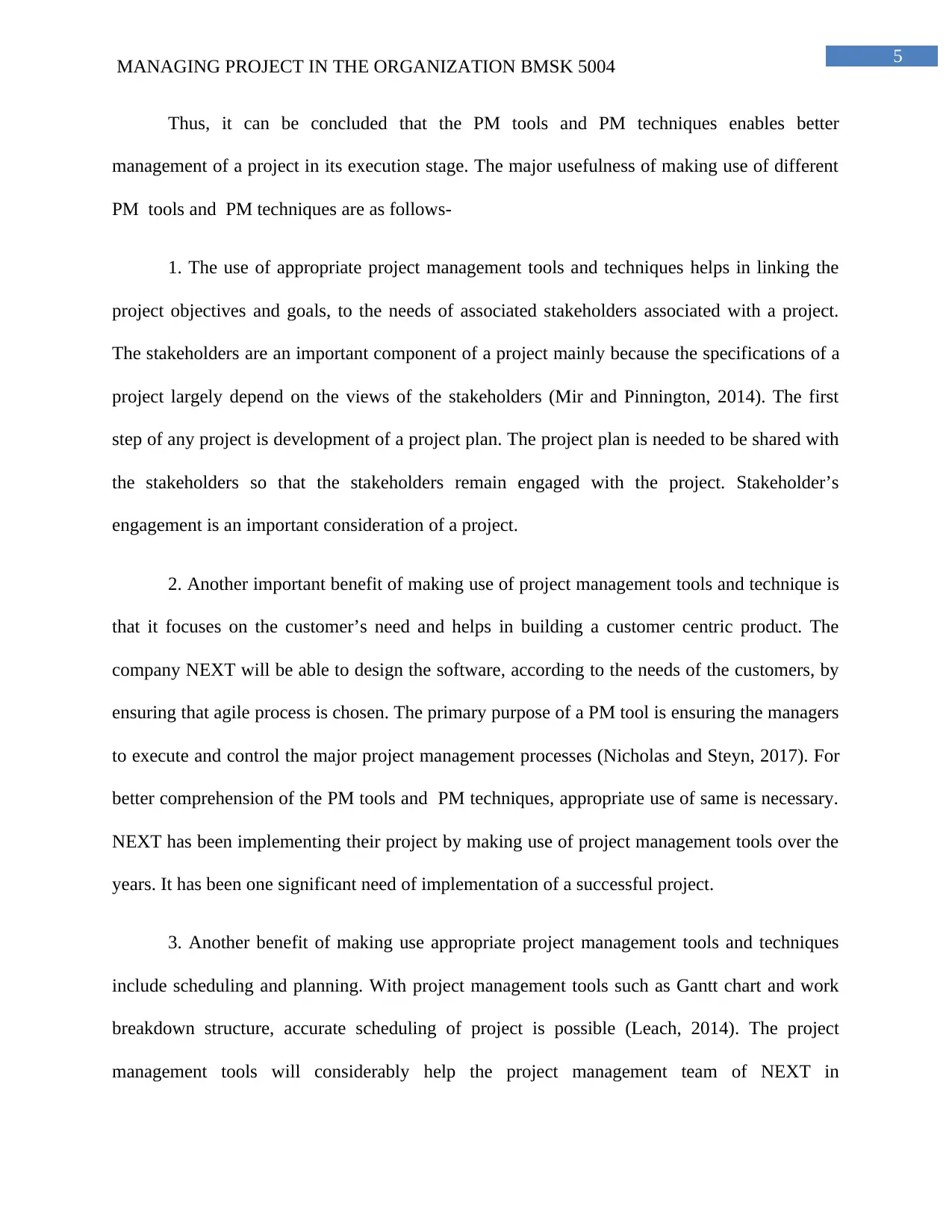
5
MANAGING PROJECT IN THE ORGANIZATION BMSK 5004
Thus, it can be concluded that the PM tools and PM techniques enables better
management of a project in its execution stage. The major usefulness of making use of different
PM tools and PM techniques are as follows-
1. The use of appropriate project management tools and techniques helps in linking the
project objectives and goals, to the needs of associated stakeholders associated with a project.
The stakeholders are an important component of a project mainly because the specifications of a
project largely depend on the views of the stakeholders (Mir and Pinnington, 2014). The first
step of any project is development of a project plan. The project plan is needed to be shared with
the stakeholders so that the stakeholders remain engaged with the project. Stakeholder’s
engagement is an important consideration of a project.
2. Another important benefit of making use of project management tools and technique is
that it focuses on the customer’s need and helps in building a customer centric product. The
company NEXT will be able to design the software, according to the needs of the customers, by
ensuring that agile process is chosen. The primary purpose of a PM tool is ensuring the managers
to execute and control the major project management processes (Nicholas and Steyn, 2017). For
better comprehension of the PM tools and PM techniques, appropriate use of same is necessary.
NEXT has been implementing their project by making use of project management tools over the
years. It has been one significant need of implementation of a successful project.
3. Another benefit of making use appropriate project management tools and techniques
include scheduling and planning. With project management tools such as Gantt chart and work
breakdown structure, accurate scheduling of project is possible (Leach, 2014). The project
management tools will considerably help the project management team of NEXT in
MANAGING PROJECT IN THE ORGANIZATION BMSK 5004
Thus, it can be concluded that the PM tools and PM techniques enables better
management of a project in its execution stage. The major usefulness of making use of different
PM tools and PM techniques are as follows-
1. The use of appropriate project management tools and techniques helps in linking the
project objectives and goals, to the needs of associated stakeholders associated with a project.
The stakeholders are an important component of a project mainly because the specifications of a
project largely depend on the views of the stakeholders (Mir and Pinnington, 2014). The first
step of any project is development of a project plan. The project plan is needed to be shared with
the stakeholders so that the stakeholders remain engaged with the project. Stakeholder’s
engagement is an important consideration of a project.
2. Another important benefit of making use of project management tools and technique is
that it focuses on the customer’s need and helps in building a customer centric product. The
company NEXT will be able to design the software, according to the needs of the customers, by
ensuring that agile process is chosen. The primary purpose of a PM tool is ensuring the managers
to execute and control the major project management processes (Nicholas and Steyn, 2017). For
better comprehension of the PM tools and PM techniques, appropriate use of same is necessary.
NEXT has been implementing their project by making use of project management tools over the
years. It has been one significant need of implementation of a successful project.
3. Another benefit of making use appropriate project management tools and techniques
include scheduling and planning. With project management tools such as Gantt chart and work
breakdown structure, accurate scheduling of project is possible (Leach, 2014). The project
management tools will considerably help the project management team of NEXT in
⊘ This is a preview!⊘
Do you want full access?
Subscribe today to unlock all pages.

Trusted by 1+ million students worldwide
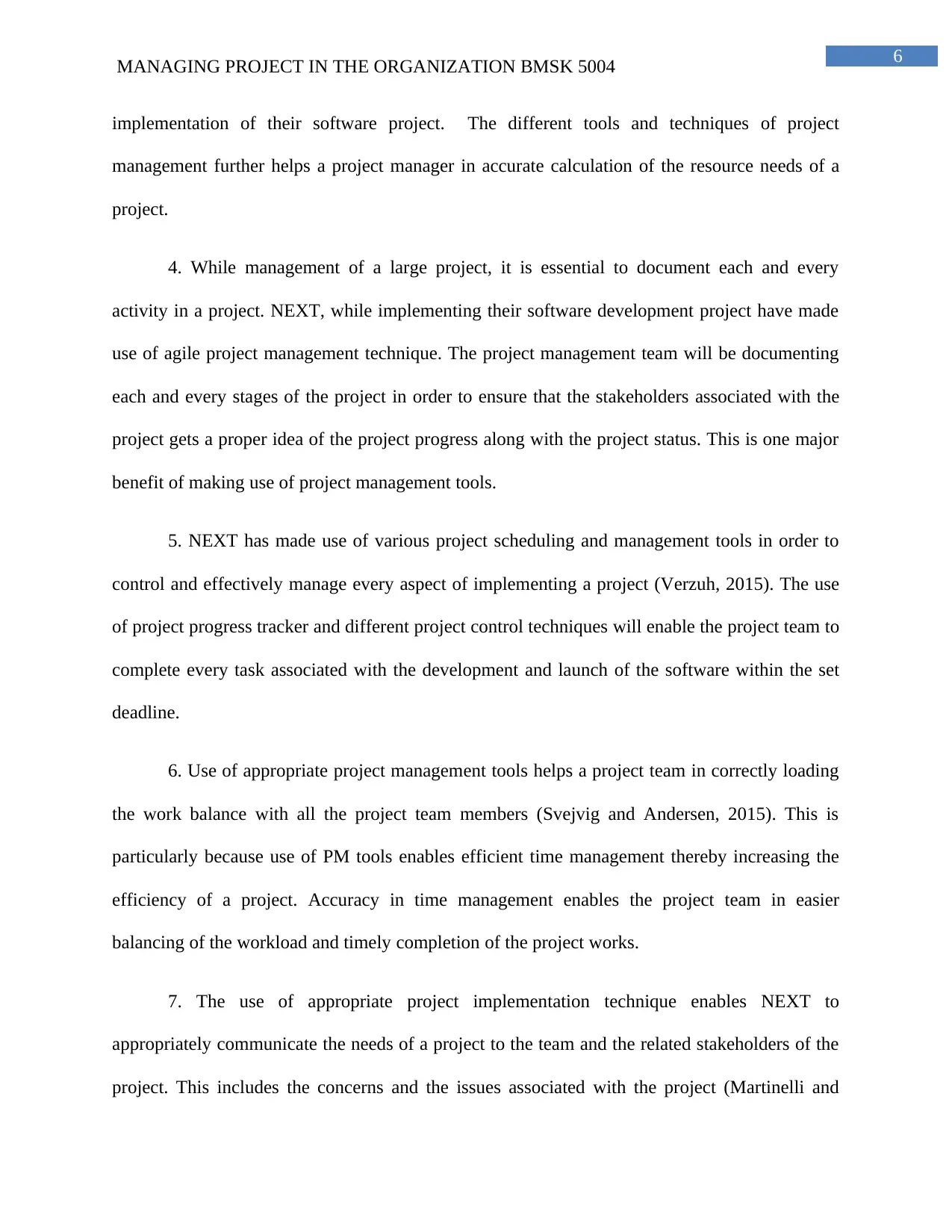
6
MANAGING PROJECT IN THE ORGANIZATION BMSK 5004
implementation of their software project. The different tools and techniques of project
management further helps a project manager in accurate calculation of the resource needs of a
project.
4. While management of a large project, it is essential to document each and every
activity in a project. NEXT, while implementing their software development project have made
use of agile project management technique. The project management team will be documenting
each and every stages of the project in order to ensure that the stakeholders associated with the
project gets a proper idea of the project progress along with the project status. This is one major
benefit of making use of project management tools.
5. NEXT has made use of various project scheduling and management tools in order to
control and effectively manage every aspect of implementing a project (Verzuh, 2015). The use
of project progress tracker and different project control techniques will enable the project team to
complete every task associated with the development and launch of the software within the set
deadline.
6. Use of appropriate project management tools helps a project team in correctly loading
the work balance with all the project team members (Svejvig and Andersen, 2015). This is
particularly because use of PM tools enables efficient time management thereby increasing the
efficiency of a project. Accuracy in time management enables the project team in easier
balancing of the workload and timely completion of the project works.
7. The use of appropriate project implementation technique enables NEXT to
appropriately communicate the needs of a project to the team and the related stakeholders of the
project. This includes the concerns and the issues associated with the project (Martinelli and
MANAGING PROJECT IN THE ORGANIZATION BMSK 5004
implementation of their software project. The different tools and techniques of project
management further helps a project manager in accurate calculation of the resource needs of a
project.
4. While management of a large project, it is essential to document each and every
activity in a project. NEXT, while implementing their software development project have made
use of agile project management technique. The project management team will be documenting
each and every stages of the project in order to ensure that the stakeholders associated with the
project gets a proper idea of the project progress along with the project status. This is one major
benefit of making use of project management tools.
5. NEXT has made use of various project scheduling and management tools in order to
control and effectively manage every aspect of implementing a project (Verzuh, 2015). The use
of project progress tracker and different project control techniques will enable the project team to
complete every task associated with the development and launch of the software within the set
deadline.
6. Use of appropriate project management tools helps a project team in correctly loading
the work balance with all the project team members (Svejvig and Andersen, 2015). This is
particularly because use of PM tools enables efficient time management thereby increasing the
efficiency of a project. Accuracy in time management enables the project team in easier
balancing of the workload and timely completion of the project works.
7. The use of appropriate project implementation technique enables NEXT to
appropriately communicate the needs of a project to the team and the related stakeholders of the
project. This includes the concerns and the issues associated with the project (Martinelli and
Paraphrase This Document
Need a fresh take? Get an instant paraphrase of this document with our AI Paraphraser
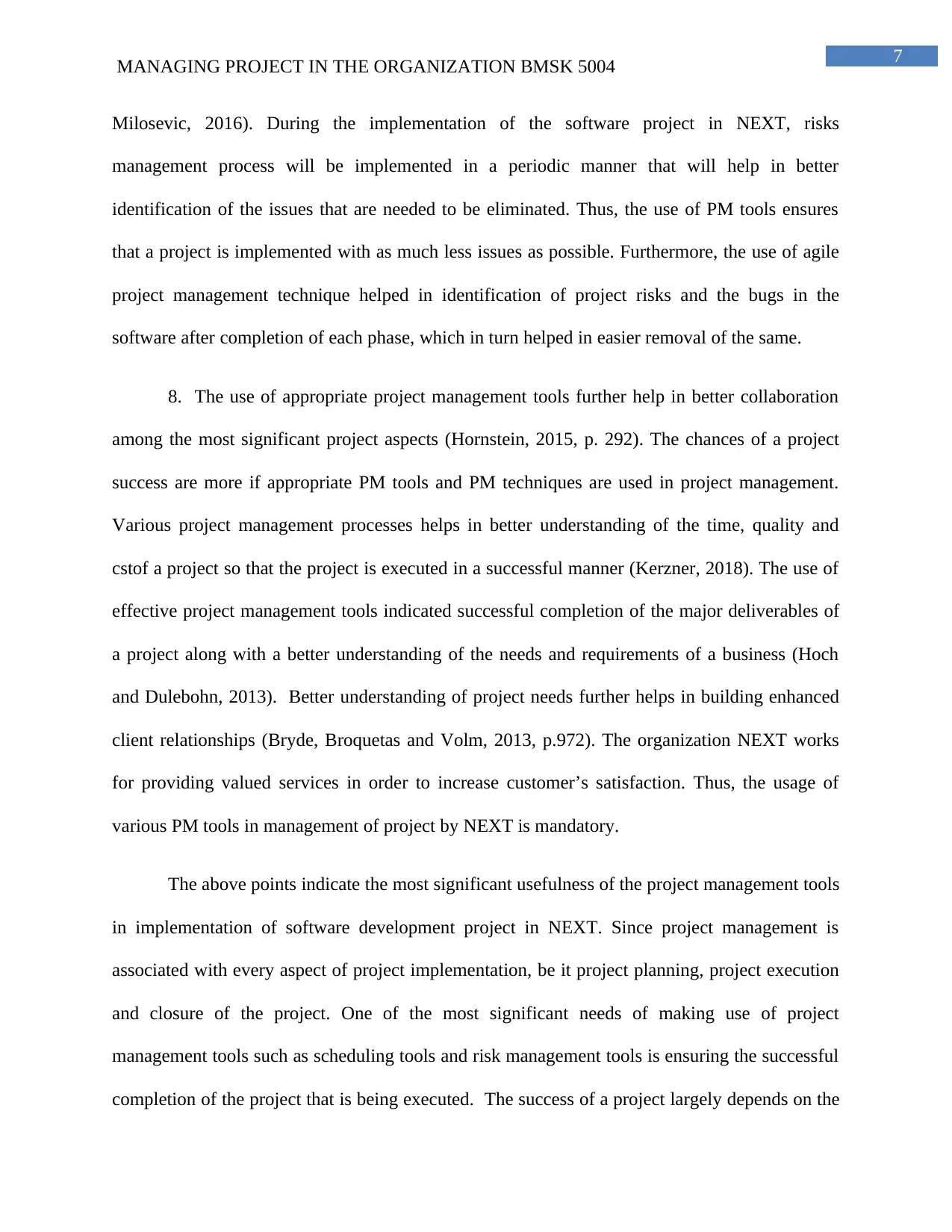
7
MANAGING PROJECT IN THE ORGANIZATION BMSK 5004
Milosevic, 2016). During the implementation of the software project in NEXT, risks
management process will be implemented in a periodic manner that will help in better
identification of the issues that are needed to be eliminated. Thus, the use of PM tools ensures
that a project is implemented with as much less issues as possible. Furthermore, the use of agile
project management technique helped in identification of project risks and the bugs in the
software after completion of each phase, which in turn helped in easier removal of the same.
8. The use of appropriate project management tools further help in better collaboration
among the most significant project aspects (Hornstein, 2015, p. 292). The chances of a project
success are more if appropriate PM tools and PM techniques are used in project management.
Various project management processes helps in better understanding of the time, quality and
cstof a project so that the project is executed in a successful manner (Kerzner, 2018). The use of
effective project management tools indicated successful completion of the major deliverables of
a project along with a better understanding of the needs and requirements of a business (Hoch
and Dulebohn, 2013). Better understanding of project needs further helps in building enhanced
client relationships (Bryde, Broquetas and Volm, 2013, p.972). The organization NEXT works
for providing valued services in order to increase customer’s satisfaction. Thus, the usage of
various PM tools in management of project by NEXT is mandatory.
The above points indicate the most significant usefulness of the project management tools
in implementation of software development project in NEXT. Since project management is
associated with every aspect of project implementation, be it project planning, project execution
and closure of the project. One of the most significant needs of making use of project
management tools such as scheduling tools and risk management tools is ensuring the successful
completion of the project that is being executed. The success of a project largely depends on the
MANAGING PROJECT IN THE ORGANIZATION BMSK 5004
Milosevic, 2016). During the implementation of the software project in NEXT, risks
management process will be implemented in a periodic manner that will help in better
identification of the issues that are needed to be eliminated. Thus, the use of PM tools ensures
that a project is implemented with as much less issues as possible. Furthermore, the use of agile
project management technique helped in identification of project risks and the bugs in the
software after completion of each phase, which in turn helped in easier removal of the same.
8. The use of appropriate project management tools further help in better collaboration
among the most significant project aspects (Hornstein, 2015, p. 292). The chances of a project
success are more if appropriate PM tools and PM techniques are used in project management.
Various project management processes helps in better understanding of the time, quality and
cstof a project so that the project is executed in a successful manner (Kerzner, 2018). The use of
effective project management tools indicated successful completion of the major deliverables of
a project along with a better understanding of the needs and requirements of a business (Hoch
and Dulebohn, 2013). Better understanding of project needs further helps in building enhanced
client relationships (Bryde, Broquetas and Volm, 2013, p.972). The organization NEXT works
for providing valued services in order to increase customer’s satisfaction. Thus, the usage of
various PM tools in management of project by NEXT is mandatory.
The above points indicate the most significant usefulness of the project management tools
in implementation of software development project in NEXT. Since project management is
associated with every aspect of project implementation, be it project planning, project execution
and closure of the project. One of the most significant needs of making use of project
management tools such as scheduling tools and risk management tools is ensuring the successful
completion of the project that is being executed. The success of a project largely depends on the
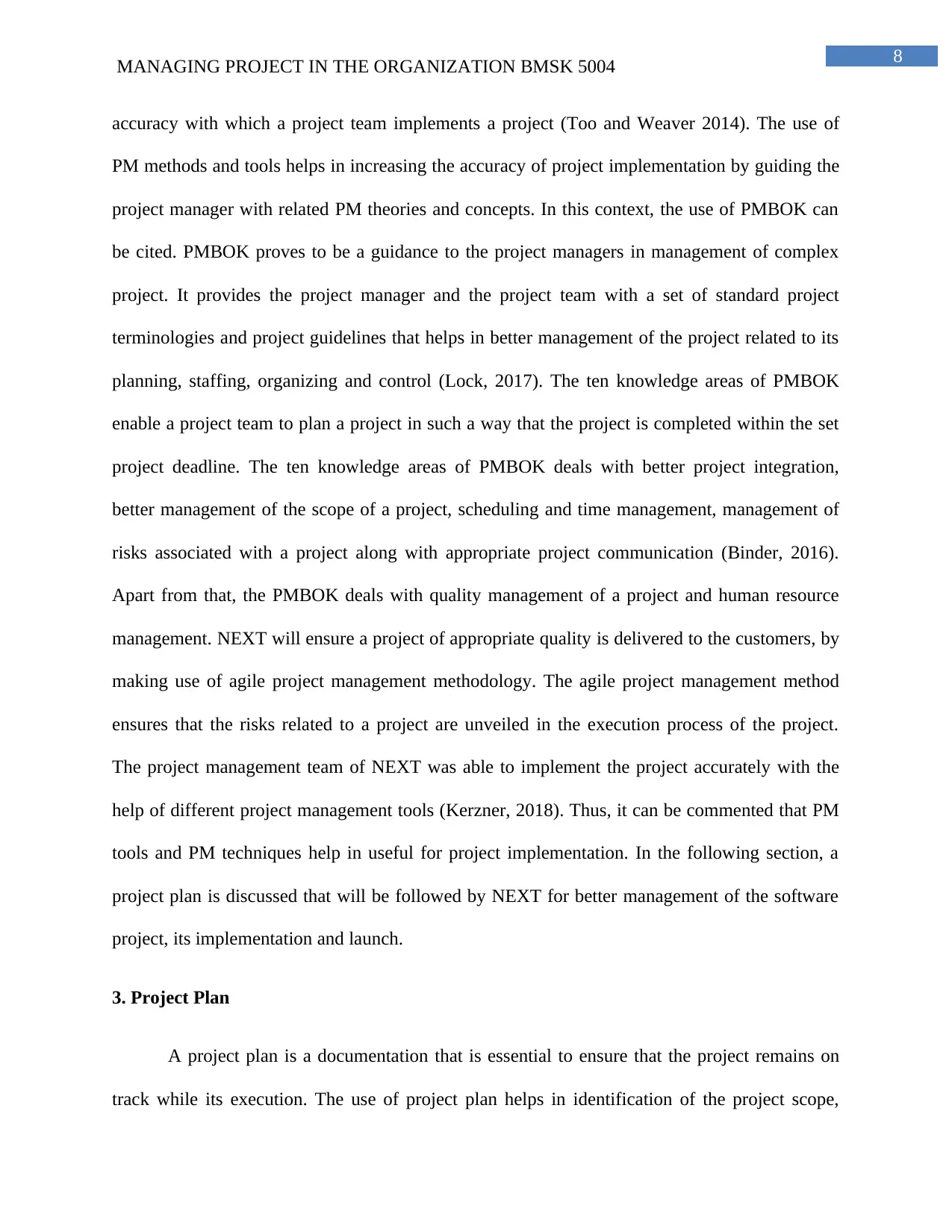
8
MANAGING PROJECT IN THE ORGANIZATION BMSK 5004
accuracy with which a project team implements a project (Too and Weaver 2014). The use of
PM methods and tools helps in increasing the accuracy of project implementation by guiding the
project manager with related PM theories and concepts. In this context, the use of PMBOK can
be cited. PMBOK proves to be a guidance to the project managers in management of complex
project. It provides the project manager and the project team with a set of standard project
terminologies and project guidelines that helps in better management of the project related to its
planning, staffing, organizing and control (Lock, 2017). The ten knowledge areas of PMBOK
enable a project team to plan a project in such a way that the project is completed within the set
project deadline. The ten knowledge areas of PMBOK deals with better project integration,
better management of the scope of a project, scheduling and time management, management of
risks associated with a project along with appropriate project communication (Binder, 2016).
Apart from that, the PMBOK deals with quality management of a project and human resource
management. NEXT will ensure a project of appropriate quality is delivered to the customers, by
making use of agile project management methodology. The agile project management method
ensures that the risks related to a project are unveiled in the execution process of the project.
The project management team of NEXT was able to implement the project accurately with the
help of different project management tools (Kerzner, 2018). Thus, it can be commented that PM
tools and PM techniques help in useful for project implementation. In the following section, a
project plan is discussed that will be followed by NEXT for better management of the software
project, its implementation and launch.
3. Project Plan
A project plan is a documentation that is essential to ensure that the project remains on
track while its execution. The use of project plan helps in identification of the project scope,
MANAGING PROJECT IN THE ORGANIZATION BMSK 5004
accuracy with which a project team implements a project (Too and Weaver 2014). The use of
PM methods and tools helps in increasing the accuracy of project implementation by guiding the
project manager with related PM theories and concepts. In this context, the use of PMBOK can
be cited. PMBOK proves to be a guidance to the project managers in management of complex
project. It provides the project manager and the project team with a set of standard project
terminologies and project guidelines that helps in better management of the project related to its
planning, staffing, organizing and control (Lock, 2017). The ten knowledge areas of PMBOK
enable a project team to plan a project in such a way that the project is completed within the set
project deadline. The ten knowledge areas of PMBOK deals with better project integration,
better management of the scope of a project, scheduling and time management, management of
risks associated with a project along with appropriate project communication (Binder, 2016).
Apart from that, the PMBOK deals with quality management of a project and human resource
management. NEXT will ensure a project of appropriate quality is delivered to the customers, by
making use of agile project management methodology. The agile project management method
ensures that the risks related to a project are unveiled in the execution process of the project.
The project management team of NEXT was able to implement the project accurately with the
help of different project management tools (Kerzner, 2018). Thus, it can be commented that PM
tools and PM techniques help in useful for project implementation. In the following section, a
project plan is discussed that will be followed by NEXT for better management of the software
project, its implementation and launch.
3. Project Plan
A project plan is a documentation that is essential to ensure that the project remains on
track while its execution. The use of project plan helps in identification of the project scope,
⊘ This is a preview!⊘
Do you want full access?
Subscribe today to unlock all pages.

Trusted by 1+ million students worldwide
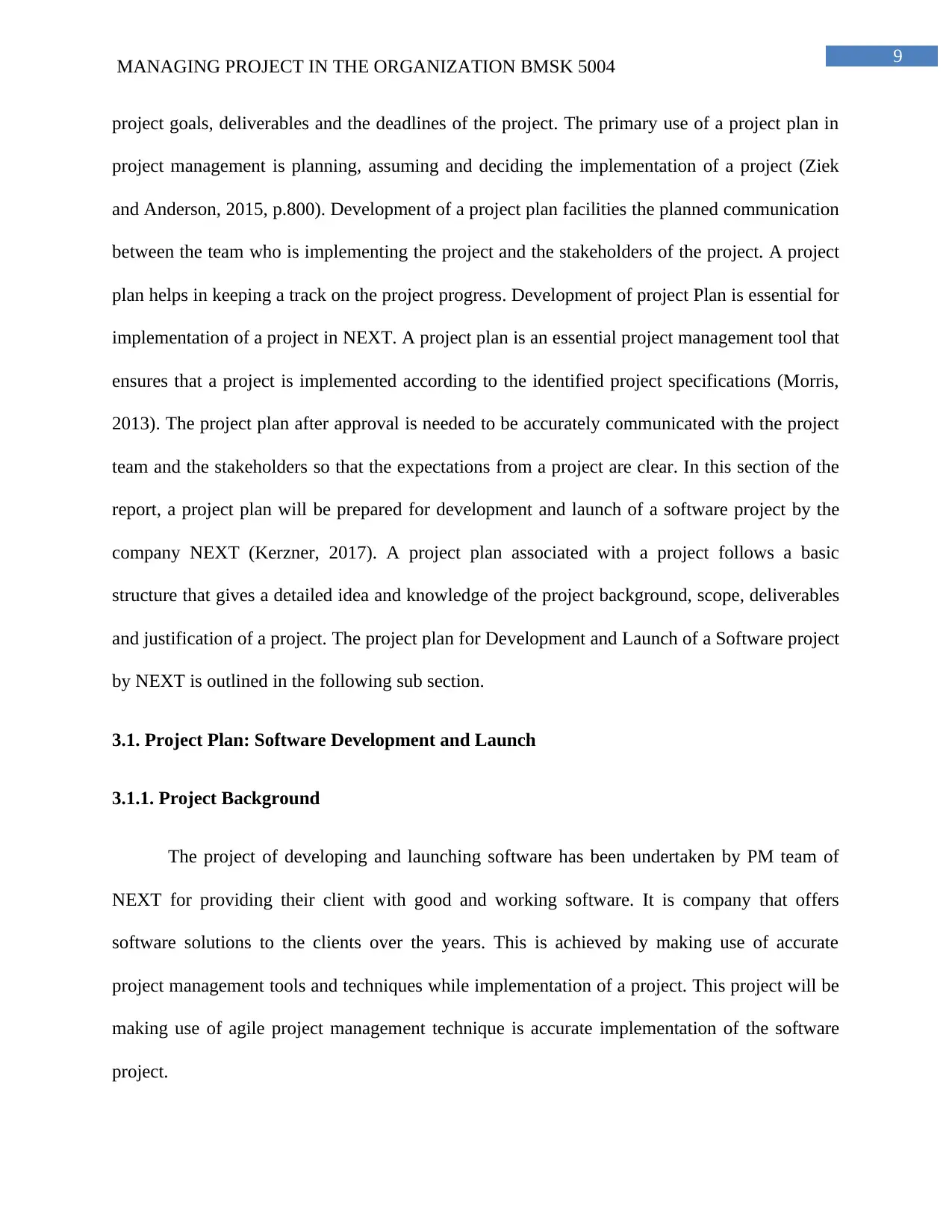
9
MANAGING PROJECT IN THE ORGANIZATION BMSK 5004
project goals, deliverables and the deadlines of the project. The primary use of a project plan in
project management is planning, assuming and deciding the implementation of a project (Ziek
and Anderson, 2015, p.800). Development of a project plan facilities the planned communication
between the team who is implementing the project and the stakeholders of the project. A project
plan helps in keeping a track on the project progress. Development of project Plan is essential for
implementation of a project in NEXT. A project plan is an essential project management tool that
ensures that a project is implemented according to the identified project specifications (Morris,
2013). The project plan after approval is needed to be accurately communicated with the project
team and the stakeholders so that the expectations from a project are clear. In this section of the
report, a project plan will be prepared for development and launch of a software project by the
company NEXT (Kerzner, 2017). A project plan associated with a project follows a basic
structure that gives a detailed idea and knowledge of the project background, scope, deliverables
and justification of a project. The project plan for Development and Launch of a Software project
by NEXT is outlined in the following sub section.
3.1. Project Plan: Software Development and Launch
3.1.1. Project Background
The project of developing and launching software has been undertaken by PM team of
NEXT for providing their client with good and working software. It is company that offers
software solutions to the clients over the years. This is achieved by making use of accurate
project management tools and techniques while implementation of a project. This project will be
making use of agile project management technique is accurate implementation of the software
project.
MANAGING PROJECT IN THE ORGANIZATION BMSK 5004
project goals, deliverables and the deadlines of the project. The primary use of a project plan in
project management is planning, assuming and deciding the implementation of a project (Ziek
and Anderson, 2015, p.800). Development of a project plan facilities the planned communication
between the team who is implementing the project and the stakeholders of the project. A project
plan helps in keeping a track on the project progress. Development of project Plan is essential for
implementation of a project in NEXT. A project plan is an essential project management tool that
ensures that a project is implemented according to the identified project specifications (Morris,
2013). The project plan after approval is needed to be accurately communicated with the project
team and the stakeholders so that the expectations from a project are clear. In this section of the
report, a project plan will be prepared for development and launch of a software project by the
company NEXT (Kerzner, 2017). A project plan associated with a project follows a basic
structure that gives a detailed idea and knowledge of the project background, scope, deliverables
and justification of a project. The project plan for Development and Launch of a Software project
by NEXT is outlined in the following sub section.
3.1. Project Plan: Software Development and Launch
3.1.1. Project Background
The project of developing and launching software has been undertaken by PM team of
NEXT for providing their client with good and working software. It is company that offers
software solutions to the clients over the years. This is achieved by making use of accurate
project management tools and techniques while implementation of a project. This project will be
making use of agile project management technique is accurate implementation of the software
project.
Paraphrase This Document
Need a fresh take? Get an instant paraphrase of this document with our AI Paraphraser
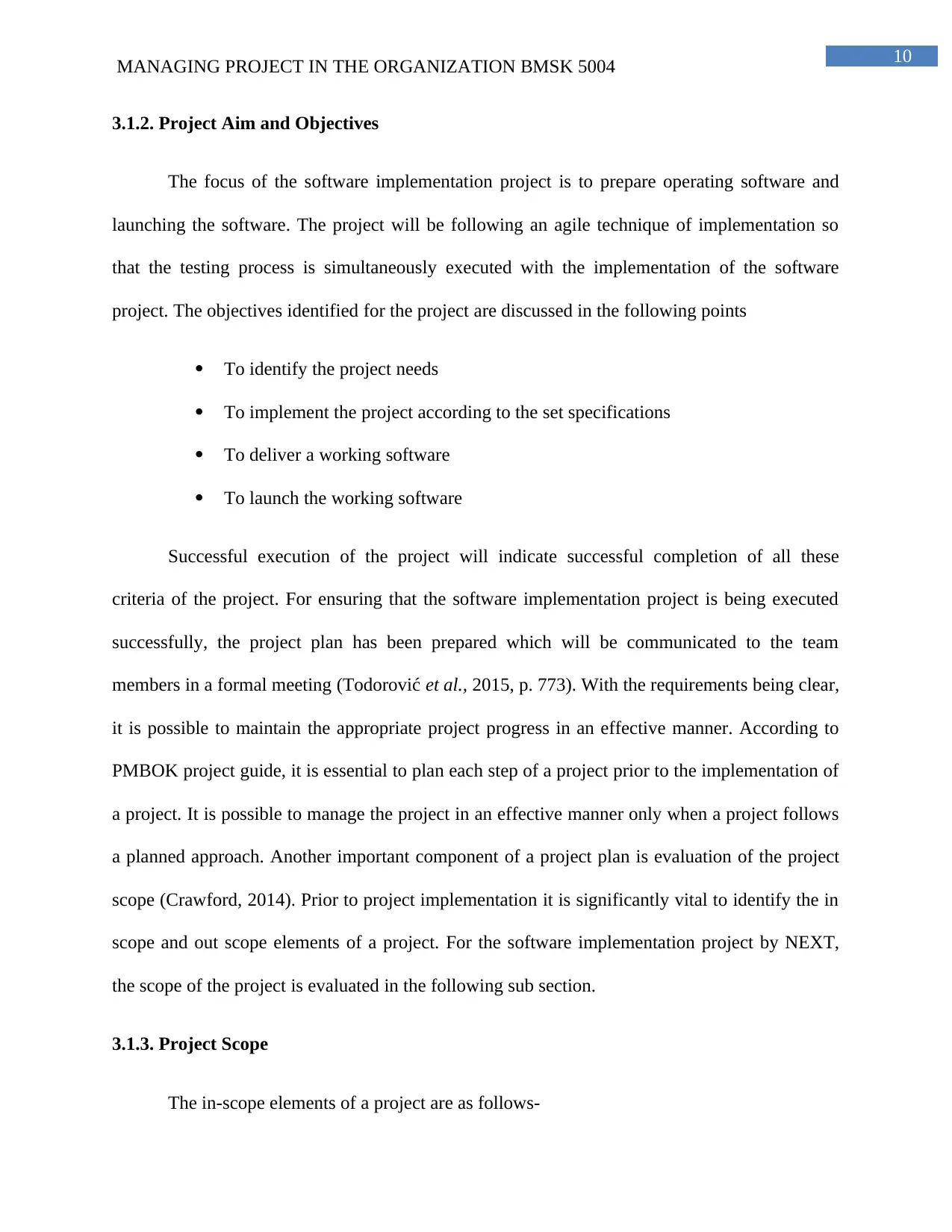
10
MANAGING PROJECT IN THE ORGANIZATION BMSK 5004
3.1.2. Project Aim and Objectives
The focus of the software implementation project is to prepare operating software and
launching the software. The project will be following an agile technique of implementation so
that the testing process is simultaneously executed with the implementation of the software
project. The objectives identified for the project are discussed in the following points
To identify the project needs
To implement the project according to the set specifications
To deliver a working software
To launch the working software
Successful execution of the project will indicate successful completion of all these
criteria of the project. For ensuring that the software implementation project is being executed
successfully, the project plan has been prepared which will be communicated to the team
members in a formal meeting (Todorović et al., 2015, p. 773). With the requirements being clear,
it is possible to maintain the appropriate project progress in an effective manner. According to
PMBOK project guide, it is essential to plan each step of a project prior to the implementation of
a project. It is possible to manage the project in an effective manner only when a project follows
a planned approach. Another important component of a project plan is evaluation of the project
scope (Crawford, 2014). Prior to project implementation it is significantly vital to identify the in
scope and out scope elements of a project. For the software implementation project by NEXT,
the scope of the project is evaluated in the following sub section.
3.1.3. Project Scope
The in-scope elements of a project are as follows-
MANAGING PROJECT IN THE ORGANIZATION BMSK 5004
3.1.2. Project Aim and Objectives
The focus of the software implementation project is to prepare operating software and
launching the software. The project will be following an agile technique of implementation so
that the testing process is simultaneously executed with the implementation of the software
project. The objectives identified for the project are discussed in the following points
To identify the project needs
To implement the project according to the set specifications
To deliver a working software
To launch the working software
Successful execution of the project will indicate successful completion of all these
criteria of the project. For ensuring that the software implementation project is being executed
successfully, the project plan has been prepared which will be communicated to the team
members in a formal meeting (Todorović et al., 2015, p. 773). With the requirements being clear,
it is possible to maintain the appropriate project progress in an effective manner. According to
PMBOK project guide, it is essential to plan each step of a project prior to the implementation of
a project. It is possible to manage the project in an effective manner only when a project follows
a planned approach. Another important component of a project plan is evaluation of the project
scope (Crawford, 2014). Prior to project implementation it is significantly vital to identify the in
scope and out scope elements of a project. For the software implementation project by NEXT,
the scope of the project is evaluated in the following sub section.
3.1.3. Project Scope
The in-scope elements of a project are as follows-
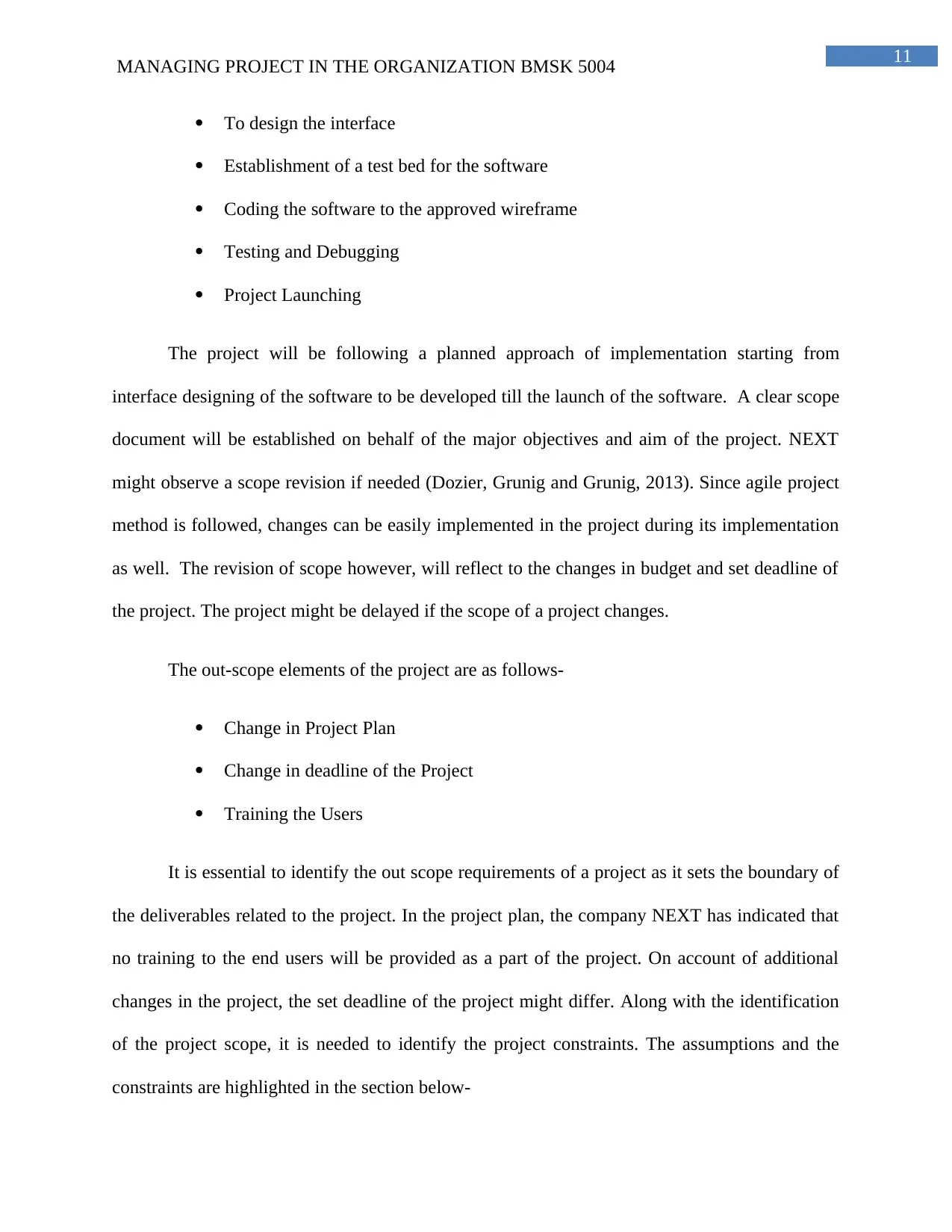
11
MANAGING PROJECT IN THE ORGANIZATION BMSK 5004
To design the interface
Establishment of a test bed for the software
Coding the software to the approved wireframe
Testing and Debugging
Project Launching
The project will be following a planned approach of implementation starting from
interface designing of the software to be developed till the launch of the software. A clear scope
document will be established on behalf of the major objectives and aim of the project. NEXT
might observe a scope revision if needed (Dozier, Grunig and Grunig, 2013). Since agile project
method is followed, changes can be easily implemented in the project during its implementation
as well. The revision of scope however, will reflect to the changes in budget and set deadline of
the project. The project might be delayed if the scope of a project changes.
The out-scope elements of the project are as follows-
Change in Project Plan
Change in deadline of the Project
Training the Users
It is essential to identify the out scope requirements of a project as it sets the boundary of
the deliverables related to the project. In the project plan, the company NEXT has indicated that
no training to the end users will be provided as a part of the project. On account of additional
changes in the project, the set deadline of the project might differ. Along with the identification
of the project scope, it is needed to identify the project constraints. The assumptions and the
constraints are highlighted in the section below-
MANAGING PROJECT IN THE ORGANIZATION BMSK 5004
To design the interface
Establishment of a test bed for the software
Coding the software to the approved wireframe
Testing and Debugging
Project Launching
The project will be following a planned approach of implementation starting from
interface designing of the software to be developed till the launch of the software. A clear scope
document will be established on behalf of the major objectives and aim of the project. NEXT
might observe a scope revision if needed (Dozier, Grunig and Grunig, 2013). Since agile project
method is followed, changes can be easily implemented in the project during its implementation
as well. The revision of scope however, will reflect to the changes in budget and set deadline of
the project. The project might be delayed if the scope of a project changes.
The out-scope elements of the project are as follows-
Change in Project Plan
Change in deadline of the Project
Training the Users
It is essential to identify the out scope requirements of a project as it sets the boundary of
the deliverables related to the project. In the project plan, the company NEXT has indicated that
no training to the end users will be provided as a part of the project. On account of additional
changes in the project, the set deadline of the project might differ. Along with the identification
of the project scope, it is needed to identify the project constraints. The assumptions and the
constraints are highlighted in the section below-
⊘ This is a preview!⊘
Do you want full access?
Subscribe today to unlock all pages.

Trusted by 1+ million students worldwide
1 out of 24
Related Documents
Your All-in-One AI-Powered Toolkit for Academic Success.
+13062052269
info@desklib.com
Available 24*7 on WhatsApp / Email
![[object Object]](/_next/static/media/star-bottom.7253800d.svg)
Unlock your academic potential
Copyright © 2020–2025 A2Z Services. All Rights Reserved. Developed and managed by ZUCOL.

